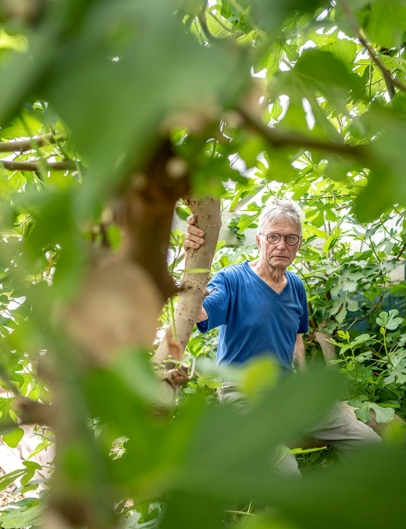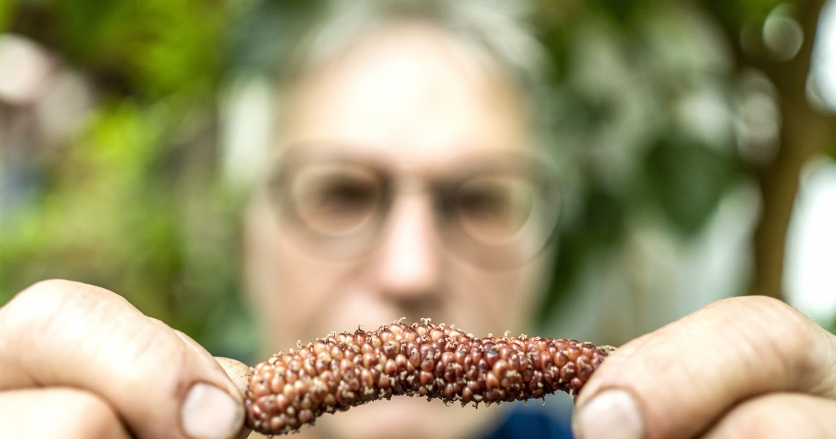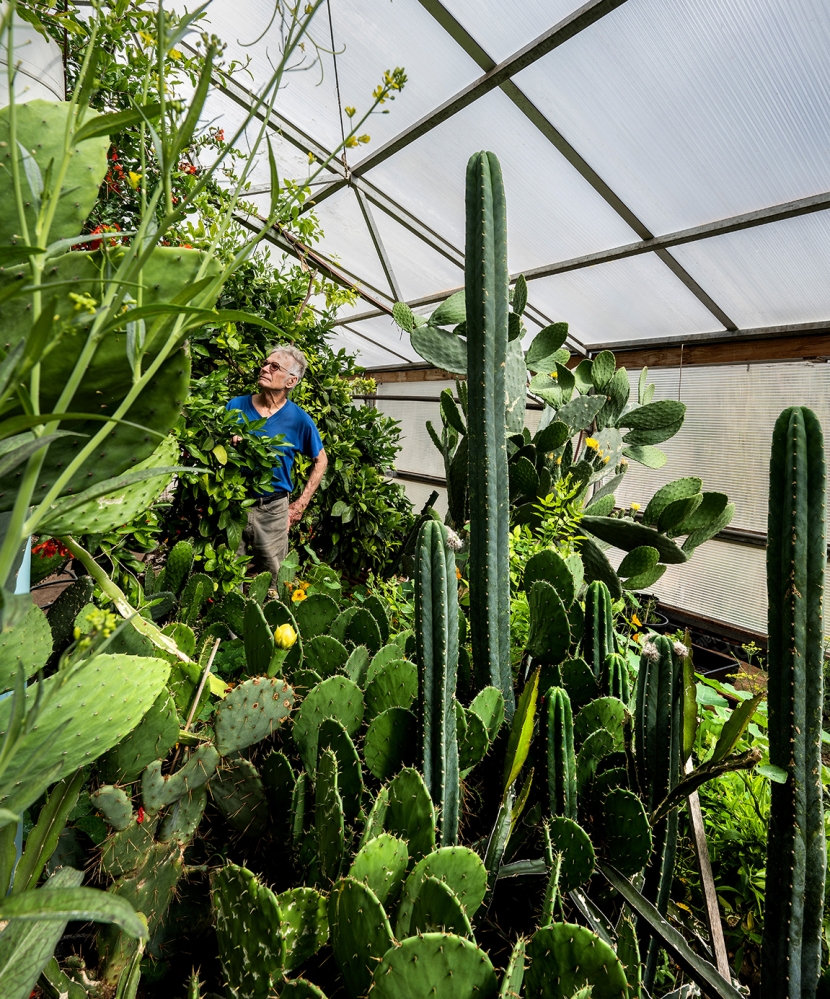Lush Life
At 80, Jerome Osentowski is realizing a lofty dream: He’s building a treehouse, complete with sleeping platform, in his backyard garden. “I’ll tie it into this Russian olive tree that I grew from a seed—30 years ago!” he marvels, surveying the project materials: a stack of wooden pallets he received for free.
Osentowski’s one-acre edible forest garden abuts 5,000 square feet of greenhouse, spread across five structures connected to his home atop a “giant rockpile with a thin veneer of vegetation” on the south face of Basalt Mountain. This is where, in 1986, Osentowski established the Central Rocky Mountain Permaculture Institute (CRMPI), “centered around education and demonstration to show people what’s possible with permaculture at 7,200 feet.”
CRMPI’s forest garden greenhouse system is one of the oldest in the country and at any given time nurtures 150 varieties of plants native to a wide range of climate zones, including tropical, Mediterranean, and warm temperate. One morning in March, the agroforester picked fresh papaya, orange, kumquats, and kale for a breakfast smoothie boosted with frozen homegrown pear, apricot, grapes, and antiviral elderberry syrup. Osentowski has supplied unconventional produce to local chefs throughout the years (see page 20), and he is credited with launching Aspen’s first farmers’ market in the mid-1980s from the back of a Hyman Avenue health food shop.
As one of North America’s foremost permaculture scholars, designers, and teachers, Osentowski consults through Eco Systems Design with partner Michael Thompson and hosts ongoing permaculture workshops. He harvests medicinal plants for tinctures sold through Jerome’s Organics, and authored The Forest Garden Greenhouse, the definitive guide for DIYers seeking to grow more sustainably. On a tour of his secluded Shangri-La, Osentowski shares his insight and vision for the future of food production.
Q: First things first: How on earth does your garden grow here?
I was doing annual gardening for 15 years. Then I switched to food foresting, or forest gardening. That’s basically carbon farming—another term we use in permaculture and agroforestry—sequestering carbon in the site [so] it builds over time. Permaculture is the new paradigm: a model of sustainable agriculture that mimics natural systems. [We’re] building soil with recycled materials: wood chips, leaves, sawdust, anything that can break down, [and] keep piling it on, making compost. We’re working with worms, mycelium, and microbes. In an aspen forest, that’s what’s happening. Nature takes care of itself.
Q: Meanwhile, your five greenhouses foster an “endless spring” at CRMPI?
We have spring year round. By having all these greenhouses, you can spread the harvest throughout the year. Three greenhouses are season-extending: We get five to six months growing in [them]. In the Mediterranean greenhouse there’s a fig nursery, pomegranate tree, two Pakistani mulberry trees, grapes, rosemary, purple basil, and cilantro. We can bring nature inside from almost any climate zone with the right design.
Q: What are the key ingredients of a food forest?
We have all layers of production: an understory, midstory, and overstory. In the tropical greenhouse, citrus, night-blooming jasmine, and cherimoya provide shade as the overstory; we used to have bananas. Midstory shrubs are Brazilian cherry and guava. Ground cover is vegetables, herbs, and insectary plants. A tuber, like sweet potato, could be in the ground as a fourth layer. Every inch of square footage needs a plant so it can turn sunlight into food. You pack in layers of resilience. That’s how natural systems can withstand climate change and crazy weather. If you had a field of lettuce, you might be out of business.
Q: Where did this journey begin for you?
My parents were homesteaders, and my great-grandfather. [My history] goes back to the original sodbusters in Nebraska: They lived in caves and ate weeds, potatoes, and rabbits in the 1860s to 1890s. Before that, the Pawnee Indians lived off the land very sustainably. This was an agricultural tribe during the summer: They grew beans, squash, and corn. Then they went on a big buffalo hunt. Everything they needed was right there along the rivers. We’re doing the same thing here [at CRMPI]. Everything we need is being thrown away down in the town, and we bring it up here and build soils.
Q: Speaking of repurposing, what does it cost to create a basic greenhouse system at home?
You can do this at any level to extend your growing season. One of our greenhouses cost $200 to put up. You can also grow potted tropical and Mediterranean plants in a sunroom and move them out on a patio in the summer. We sell dwarf citrus, figs, and pomegranates for this purpose. If you have a small backyard, an edible food forest can provide fruits and vegetables. Plant fence lines with shrubs and vines with edible berries and grapes, using the fence as a trellis. Mulch out part of your lawn and put in three or four fruit trees. This could all be on a drip irrigation system, heavily mulched, which minimizes water use and builds fertility in the soil. Once the system is installed, time commitment is minimal.
Q: What else do you share in sold-out workshops at CRMPI?
I’m teaching how to grow a perennial garden, but also how to grow for market. How do you sell that crop three different times? You can grow it for cutting. You can dig it up and sell it at a plant sale. You can eat it yourself or feed it to your animals. When it goes to seed, you harvest the seed. And then it comes back next year. That’s what’s so unique about a perennial food forest: multiple yields.
Q: Why is permaculture important as we emerge from a global pandemic in 2021?
Food is getting more expensive. We’re in for a big wakeup call, I think, as far as food production. People aren’t grounded unless they have a piece of land and are growing their own food. It’s a primal urge.
Q: What is your vision for the future of food in our valley?
Each town should have its own community farm. They have rodeo arenas, ice skating rinks, rec centers, swimming pools, and parks, but they don’t have their own farm! It’s so logical. Carbondale has a 40-acre parcel; it’s a dog run. They [could build] a farm, orchard, and 10,000-squarefoot greenhouse and training center for high-altitude gardening. A food hub, where all the food goes to a co-op, where people can work for food or buy it for a local price. You don’t need an $800,000 sidewalk! Put some wood chips on the damn thing and let people walk on that. ❧








